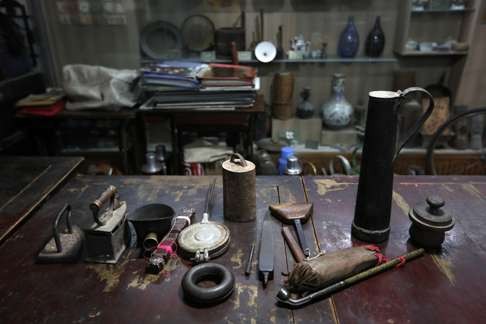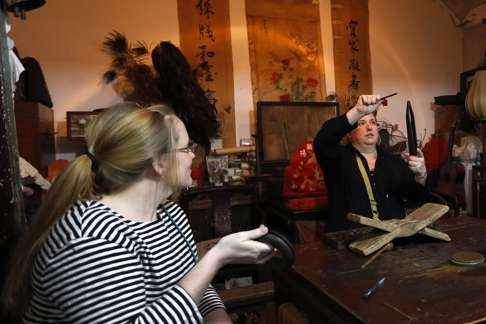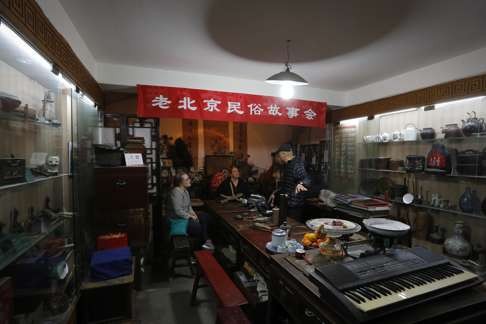
From limos to junk, quirky museums tell Beijing's history
Born from their founders’ hobbies and obsessions, these interesting repositories show visitors a largely forgotten layer of the Chinese capital’s recent past

Stuffed into a tiny room off an alleyway are items that Wang Jinming readily admits were put out with the garbage: paper string, a needle holder, a metal pancake maker built for thrusting into a fire.
“These objects all look quite old and shabby,” he says. “But they record real history.”
Wang’s Beijing Old Items Exhibition in the heart of old Beijing is one of dozens of private museums that dot the capital’s back streets and its suburbs.
Their collections feature the grand and mundane – from items salvaged from the trash to a limousine in which Mao Zedong once rode.

While state-run museums seek mainly to legitimise the ruling Communist Party through its own highly selective interpretation of history, the capital’s private museums are born from their founders’ hobbies and obsessions, along with a sense of duty to keep alive a little bit of history others might dismiss as trivial.
“If you throw it on the street, people would say ‘What’s this?’ and maybe think it’s useless and throw it away,” says Wang, gesturing around the room packed with hundreds of household items and street objects dating from the 1900s to the 1970s. “But we think it’s culture.”
Wang delights in telling visitors to guess what the objects are in their hands. They might include a popsicle holder used by street vendors or a bucket-shaped iron heated by charcoal. All form part of the collection that Wang and two co-founders began in the 1980s after asking foreign visitors why they were so interested in buying old everyday items.
“They said, ‘To collect.’ Now if you go to someone’s home you probably can’t find such things,” Wang says.

“When you heard this sound, the doctor was walking in the street, available, ringing the bell,” hesays.
Liu Chen, 27, first visited the museum after reading about it on social media and has returned several times with friends.
“It’s not like big state-owned museums. You don’t need to buy a ticket to enter some sort of grand hall and stroll through different chambers,” he says.
“Here many of the old objects displayed might have been the kind of things used by Mr Wang himself when he was a kid, so you can feel his enthusiasm, which is the key thing that distinguishes it from other museums.”
As China grows richer, wealthy citizens, banks and private businesses have invested in Chinese art and started museums to display their wealth or patriotism. Others, such as Luo Wenyou, opened their collections after their pastimes evolved into callings.
In 1998, when he already owned about 70 old cars, Luo took part in an 800-kilometre rally from the northeastern city of Dalian to Beijing, his iconic Red Flag sedan the only Chinese car in the event.
Having learned about vintage car associations and museums outside China, and inspired by shouts of “long live Red Flag” as he pulled up to Tiananmen Square, Luo decided he was honour-bound to preserve the legacy of China’s early motoring history.
“I had a karting track, a transport company and a garage. After the rally I sold them off cheaply in order to immediately start a vintage car association and later found the museum, to fill the gap,” says Luo. “I felt this was my personal duty.”
His museum opened in 2009 and he now boasts more than 200 vintage Chinese and foreign cars.

Even if just one person comes we will open, even though the entrance fee won’t cover the electricity
Luo lives at the site with his wife so he can open up outside normal hours for visitors travelling from afar.
“Even if just one person comes we will open, even though the entrance fee won’t cover the electricity,” he says.
Private collections like Luo’s offer a welcome alternative to state museums that seek to draw the visitor into a narrative about the greatness of China and the necessity of the Communist Party’s leadership, says Philip Tinari, director of the Ullens Centre for Contemporary Art in Beijing.
“You don’t really find publicly supported pockets of weirdness,” Tinari says.
Ma Weidu opened China’s first private museum in 1996, filling it with antiques bought cheaply in the late 1970s and ’80s from Beijing residents eager for cash to buy refrigerators, TVs and washing machines.
“I could buy 10 average pieces of art for 65 yuan,” says Ma.
In those early days, his most valuable acquisition was a bowl made in an imperial kiln during the reign of the Qing dynasty emperor Qianlong about 250 years ago, Ma says.
Purchased for just 6 yuan at the time, it could be worth as much as 600,000 yuan if sold today, he says.
Ma’s Guanfu Museum now has three branches across China with two more opening this year.
Ma himself has become a TV personality, hosting programmes teaching antique hunters how to discern between real treasures and fakes.
Ever keen to attract more visitors, Ma, a cat lover, recently named 20 felines as assistant curators.
“A lot of people who come to the museum ... are more interested in cats than culture,” says Ma. “But some may come here because of the cats and in doing so learn something about antiques.”